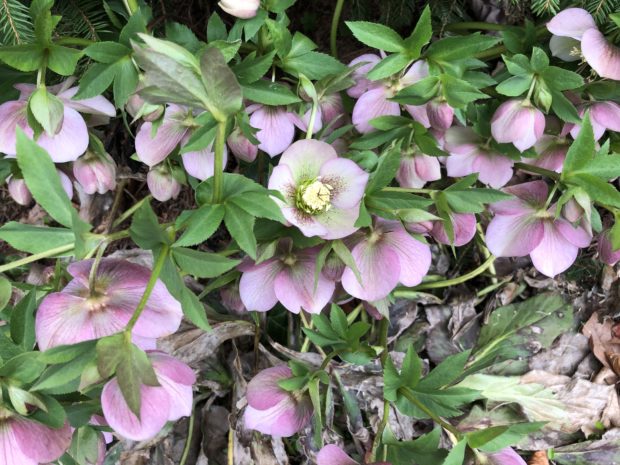 My first exposure to hellebores was likely in the 1970’s. Though gardening consumed every available moment and most of any available cash I had for plants, there were no hellebores in my yard. I could buy five other plants for the money it took to buy one hellebore. My Mom, on the other hand, being much more solvent than I, had an ever expanding collection. At first, I could not understand her fascination with them. Topping out at a foot or 16″ tall, it took 5 years to grow on a decent sized clump. The foliage was certainly attractive, but the flowers left quite a bit to be desired. Enjoying them was a necessarily interactive experience. The flowering stems were lax and thin. To enjoy them, one needed to bend over to half one’s height, pick up the drooping bloom, and turn it skyward. As pictured above, helleborus x hybridus varieties of old provided the gardener an excellent view of the flower’s backsides. The one flower looking at you was a bloom that I cut, and laid face up on the plant. Not that the back wasn’t beautiful, it just did not provide the thrill of a full front view. As in, face to face.
My first exposure to hellebores was likely in the 1970’s. Though gardening consumed every available moment and most of any available cash I had for plants, there were no hellebores in my yard. I could buy five other plants for the money it took to buy one hellebore. My Mom, on the other hand, being much more solvent than I, had an ever expanding collection. At first, I could not understand her fascination with them. Topping out at a foot or 16″ tall, it took 5 years to grow on a decent sized clump. The foliage was certainly attractive, but the flowers left quite a bit to be desired. Enjoying them was a necessarily interactive experience. The flowering stems were lax and thin. To enjoy them, one needed to bend over to half one’s height, pick up the drooping bloom, and turn it skyward. As pictured above, helleborus x hybridus varieties of old provided the gardener an excellent view of the flower’s backsides. The one flower looking at you was a bloom that I cut, and laid face up on the plant. Not that the back wasn’t beautiful, it just did not provide the thrill of a full front view. As in, face to face.
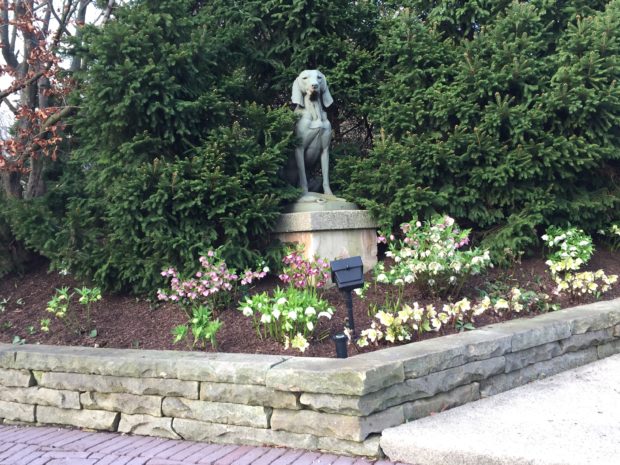 The flowers were about the size of a quarter or half dollar. They were broad and weighty compared to the stem. No wonder the flowers were nodding. Another more compelling reason for their down facing blooms is practical. Upfacing large flowers can suffer damage from rain and rot, that could interfere with the production of seed. The stalk attached to the flower is known as the peduncle. This word itself suggests something robust and strong, but the stems of these hellebore flowers could not have held a flower in the upright position. It always amused my Mom when I would lie down on the ground next to one of her plants, and try to peer up at the flowers. The colors of the flowers were equally as unsatisfying. The thin petals of the white flowered strains were a dirty white, most likely due to their translucence. The reds were overlaid with green, and the pinks were anemic.
The flowers were about the size of a quarter or half dollar. They were broad and weighty compared to the stem. No wonder the flowers were nodding. Another more compelling reason for their down facing blooms is practical. Upfacing large flowers can suffer damage from rain and rot, that could interfere with the production of seed. The stalk attached to the flower is known as the peduncle. This word itself suggests something robust and strong, but the stems of these hellebore flowers could not have held a flower in the upright position. It always amused my Mom when I would lie down on the ground next to one of her plants, and try to peer up at the flowers. The colors of the flowers were equally as unsatisfying. The thin petals of the white flowered strains were a dirty white, most likely due to their translucence. The reds were overlaid with green, and the pinks were anemic.
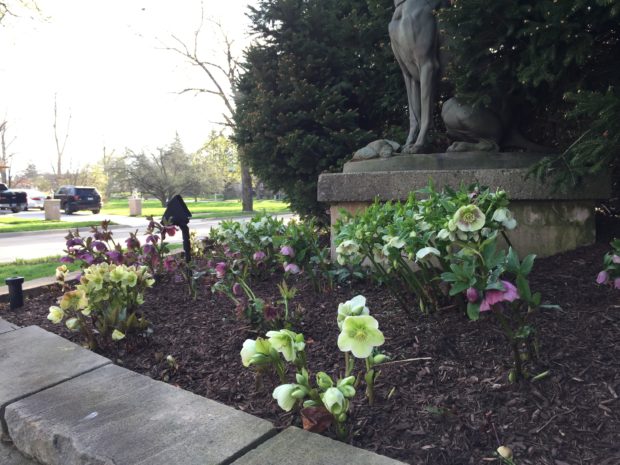 My Mom, however, was delighted with all of them. In retrospect, I attribute that to her taste, experience and sophistication in regards to garden plants. I had none of that going for me, in my 20’s. She thought her hellebores possessed a quiet and diminutive beauty. She organized an entire garden around them, and that moment when their blooming would kick off the spring season. There is something to be said for old fashioned flowers, whose size, stature, substance and color has not been tinkered with by a breeder. There are those who prefer the old fashioned feverfew to their button style double counterparts. Single flowered hollyhocks are so beautiful. The double flowered varieties look alarmingly like tissue papers suitable for a parade float.
My Mom, however, was delighted with all of them. In retrospect, I attribute that to her taste, experience and sophistication in regards to garden plants. I had none of that going for me, in my 20’s. She thought her hellebores possessed a quiet and diminutive beauty. She organized an entire garden around them, and that moment when their blooming would kick off the spring season. There is something to be said for old fashioned flowers, whose size, stature, substance and color has not been tinkered with by a breeder. There are those who prefer the old fashioned feverfew to their button style double counterparts. Single flowered hollyhocks are so beautiful. The double flowered varieties look alarmingly like tissue papers suitable for a parade float.
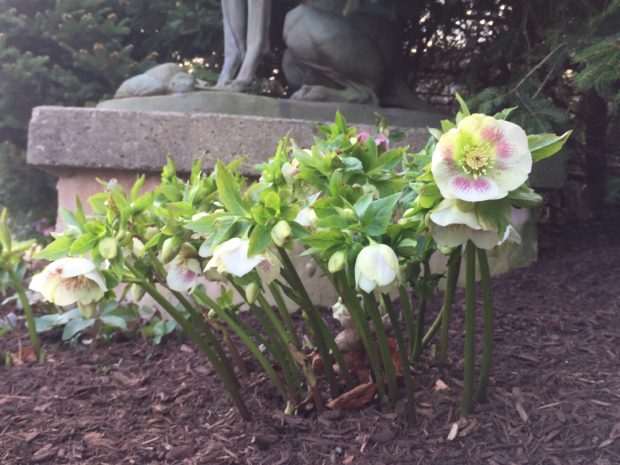 The irregularly blushing coloration of this Royal Heritage strain hellebore flower is charming, not arresting. I was lucky to have a single flower, by virtue of the support provided by the flower bud below it, face out. Otherwise, I would have no idea what the flowers look like. What a shy group this is!
The irregularly blushing coloration of this Royal Heritage strain hellebore flower is charming, not arresting. I was lucky to have a single flower, by virtue of the support provided by the flower bud below it, face out. Otherwise, I would have no idea what the flowers look like. What a shy group this is!
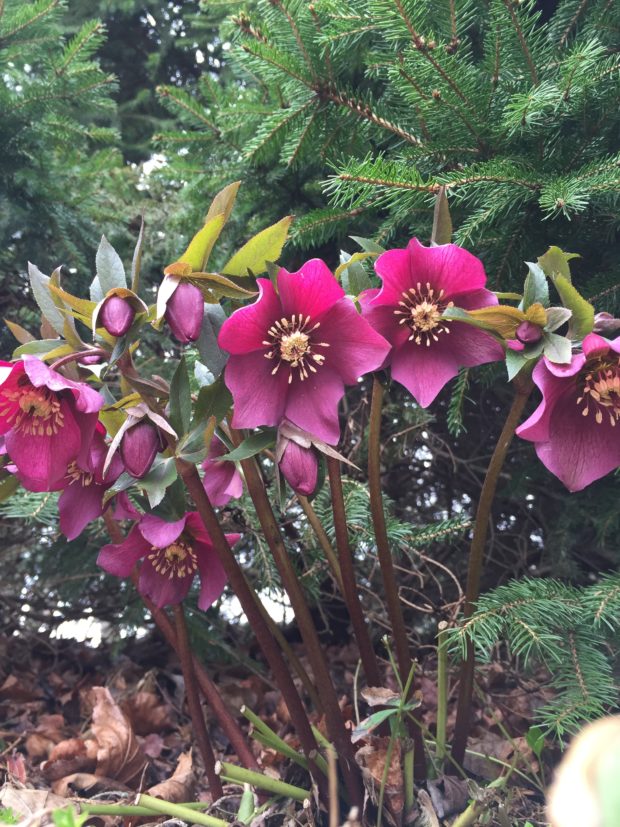 This rose pink seed grown hellebore from the same strain has small rather pointed petals that do not overlap so much. This particular plant has more side facing flowers than nodders, so it is easier to enjoy.
This rose pink seed grown hellebore from the same strain has small rather pointed petals that do not overlap so much. This particular plant has more side facing flowers than nodders, so it is easier to enjoy.
 This is one of my favorites from this old fashioned group. I picked the flower, and set it on the ground to photograph it. This is a good photograph for identifying the flower parts. What appear to be pink petals are actually modified petals known as sepals. Most flowers drop their petals one they are fertilized. But these pink sepals will age to green, and persist on the plant for many weeks. A group of sepals form a calyx, the purpose of which is to protect the flower, and its reproductive parts. The actual flower is comprised of short petals that have rolled up, closed, and formed tubes, or nectaries. In this picture, the nectaries are those green crescent shaped forms that encircle all the reproductive parts. The stamens, or male reproductive parts, have anthers at the top, which hold the pollen. They appear as cream white dots in the above picture. The female reproductive parts, the pointy shaped carpels, have not grown out yet. When they do, they will grow and enlarge into what will become the seeds. The sex lives of plants is complex and fascinating-and requires the assistance a third disinterested party, as in insects, wind, or bees.
This is one of my favorites from this old fashioned group. I picked the flower, and set it on the ground to photograph it. This is a good photograph for identifying the flower parts. What appear to be pink petals are actually modified petals known as sepals. Most flowers drop their petals one they are fertilized. But these pink sepals will age to green, and persist on the plant for many weeks. A group of sepals form a calyx, the purpose of which is to protect the flower, and its reproductive parts. The actual flower is comprised of short petals that have rolled up, closed, and formed tubes, or nectaries. In this picture, the nectaries are those green crescent shaped forms that encircle all the reproductive parts. The stamens, or male reproductive parts, have anthers at the top, which hold the pollen. They appear as cream white dots in the above picture. The female reproductive parts, the pointy shaped carpels, have not grown out yet. When they do, they will grow and enlarge into what will become the seeds. The sex lives of plants is complex and fascinating-and requires the assistance a third disinterested party, as in insects, wind, or bees.
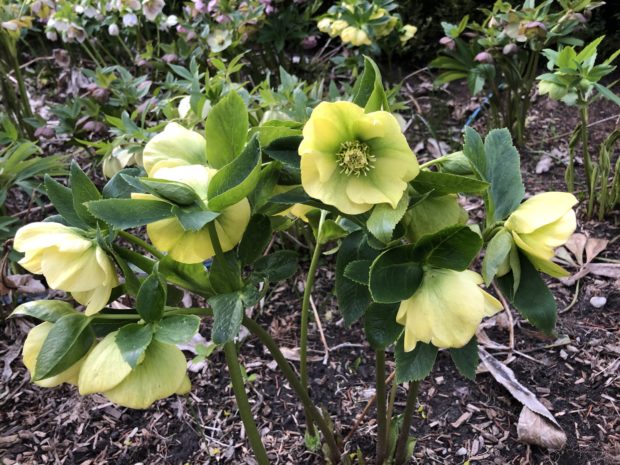 The newer cultivars of hellebores are quite astonishing. I still remember the first time I saw a yellow flowered hellebore. I could hardly believe it was real. The above pictured hellebore from the Spring Promise series is called Sally. It is a robust grower. As many flowers face out to the side as face down. Outfacing flowers are still able to shed rain water, limiting rot in the center of the flower. More flowers than not have 7 sepals, as opposed to the old fashioned 5. There is a good bit of overlap to the sepals, resulting in color that is richer and more brilliant.
The newer cultivars of hellebores are quite astonishing. I still remember the first time I saw a yellow flowered hellebore. I could hardly believe it was real. The above pictured hellebore from the Spring Promise series is called Sally. It is a robust grower. As many flowers face out to the side as face down. Outfacing flowers are still able to shed rain water, limiting rot in the center of the flower. More flowers than not have 7 sepals, as opposed to the old fashioned 5. There is a good bit of overlap to the sepals, resulting in color that is richer and more brilliant.
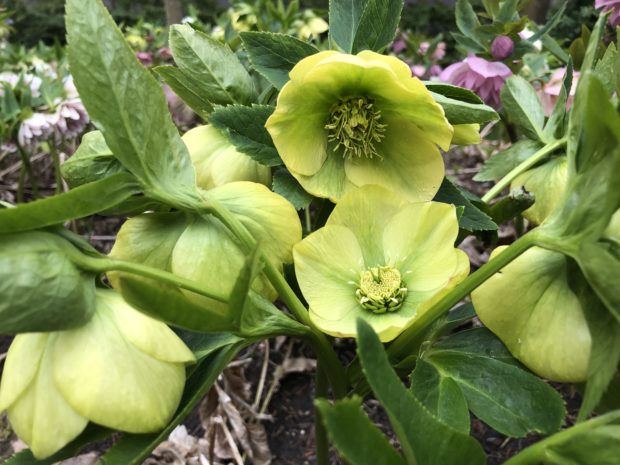 The size of the flowers is considerable larger than those on my older hybrids. 15 flowers of this size gives the plant the impact of a small shrub.
The size of the flowers is considerable larger than those on my older hybrids. 15 flowers of this size gives the plant the impact of a small shrub.
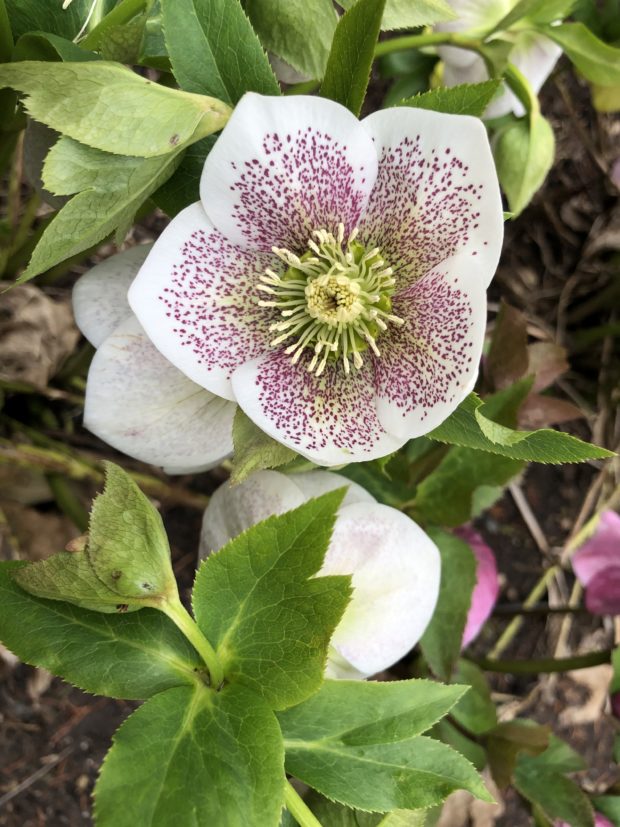 Also a member of the “Spring Promise” series is this named variety, Connie. The white sepals have plenty of substance, meaning they are thick enough to read bright white. The spots are a striking visual plus. I am sure there is every bit of 150 stamens on this flower. There are so many, the nectaries are almost completely obscured. It has an exotic, rather than charming appearance.
Also a member of the “Spring Promise” series is this named variety, Connie. The white sepals have plenty of substance, meaning they are thick enough to read bright white. The spots are a striking visual plus. I am sure there is every bit of 150 stamens on this flower. There are so many, the nectaries are almost completely obscured. It has an exotic, rather than charming appearance.
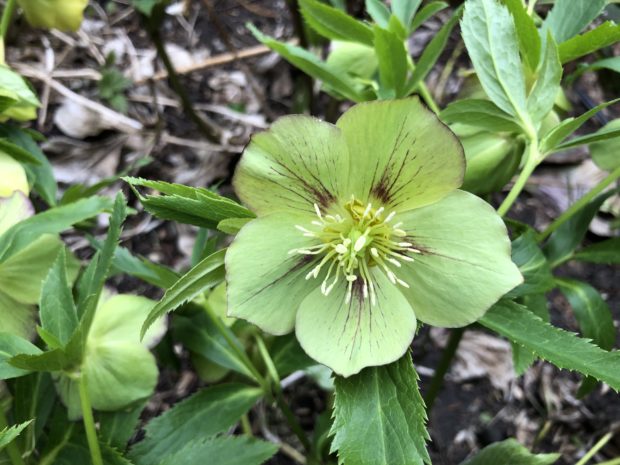 From the hybridizing efforts of Marietta Byrnes, her “Winter Jewels” strain known as Jade Star” features green flowers with maroon red markings and picotee edging. The original plants in her strain have large areas of plum and wine red over the green, but seedlings can vary considerably from the original.
From the hybridizing efforts of Marietta Byrnes, her “Winter Jewels” strain known as Jade Star” features green flowers with maroon red markings and picotee edging. The original plants in her strain have large areas of plum and wine red over the green, but seedlings can vary considerably from the original.
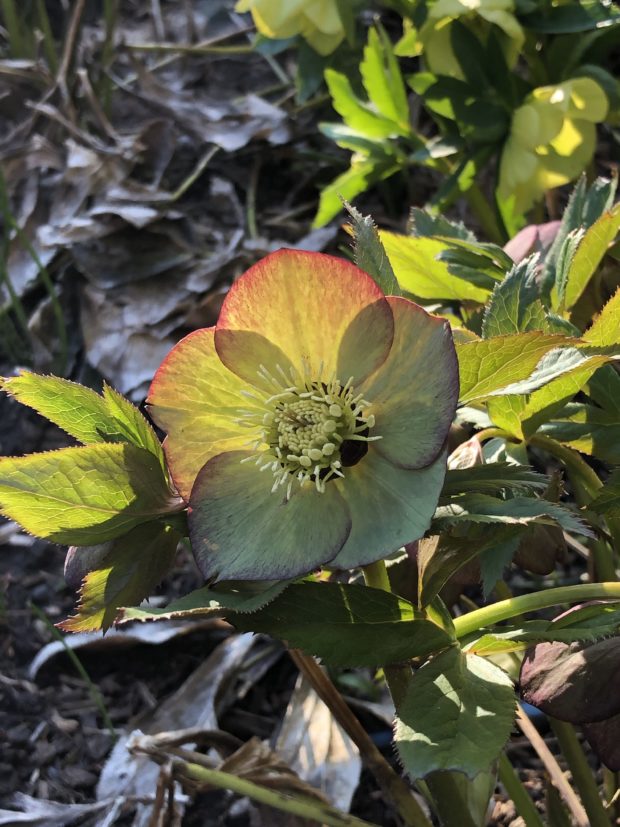 This is another version of Jade Star. Since hellebores from a strain do not come true to seed, it is best to pick them in flower so you know exactly what you will get. That said, I like every version of this moody colored hellebore strain I have seen.
This is another version of Jade Star. Since hellebores from a strain do not come true to seed, it is best to pick them in flower so you know exactly what you will get. That said, I like every version of this moody colored hellebore strain I have seen.
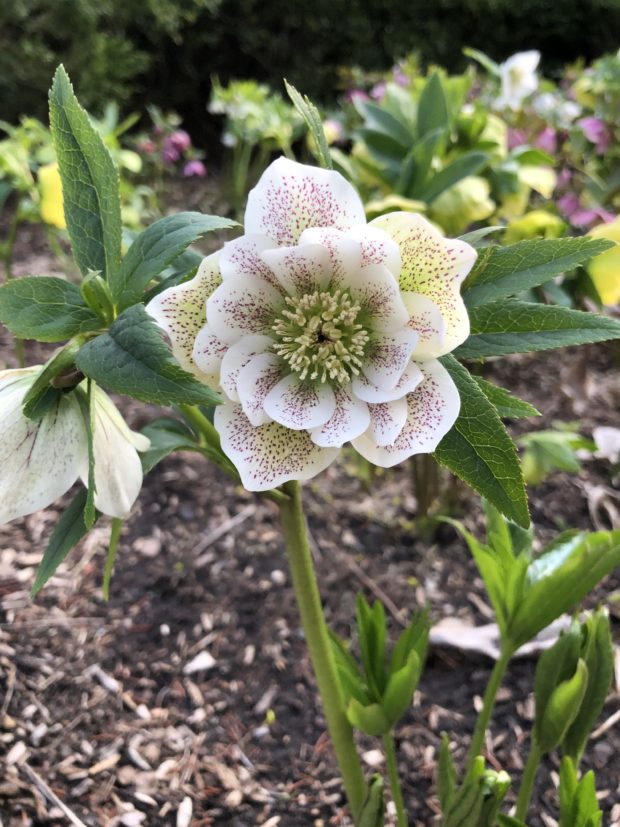 The double flowered hellebores are indeed showstopping. This particular plant is from the helleborus x hybridus Winter Dreams series “Elegance White”. In all the years I have had it, it has increased only modestly. But as reluctant as it is to put on weight, it is breathtaking, and well worth the wait.
The double flowered hellebores are indeed showstopping. This particular plant is from the helleborus x hybridus Winter Dreams series “Elegance White”. In all the years I have had it, it has increased only modestly. But as reluctant as it is to put on weight, it is breathtaking, and well worth the wait.
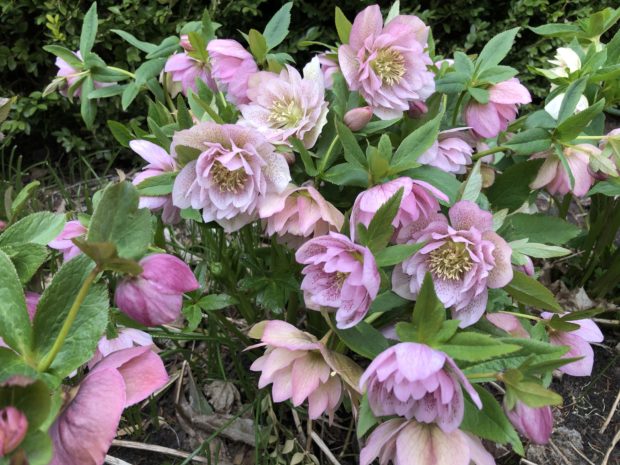 This double pink hellebore is also from the Spring Promise series, and is called “Frilly Kitty”. 7 years post planting, it is spectacular in size and bloom this year. Hellebores of any genetic background increase slowly, so the cost of good sized plants is considerable. This cultivar is vigorous and healthy, and gets no care from me besides supplemental water when it is dry. This is breathtaking example of what modern hybridizing has achieved. Is it better? I like having a range of cultivars both great and small.
This double pink hellebore is also from the Spring Promise series, and is called “Frilly Kitty”. 7 years post planting, it is spectacular in size and bloom this year. Hellebores of any genetic background increase slowly, so the cost of good sized plants is considerable. This cultivar is vigorous and healthy, and gets no care from me besides supplemental water when it is dry. This is breathtaking example of what modern hybridizing has achieved. Is it better? I like having a range of cultivars both great and small.
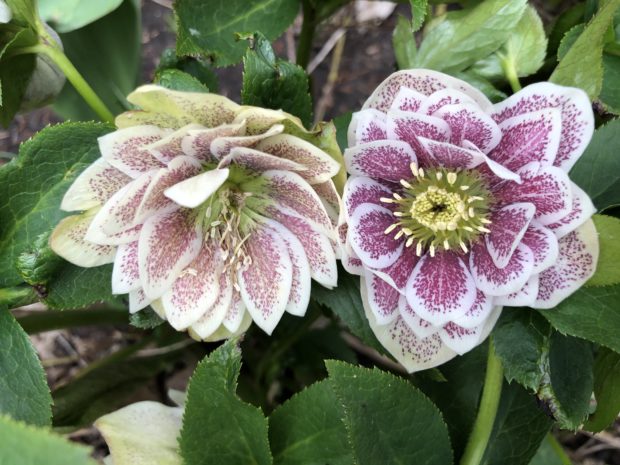 I cannot remember your name, but I am happy to be hosting you in my garden.
I cannot remember your name, but I am happy to be hosting you in my garden.
Deborah, what is your experience in dividing or transplanting hellebores? I have some good-sized clumps that I would like to place for better viewing.
Dear Kit, I have never had the nerve to dig them up and divide them, but lots of other gardeners have. See the comment on my last post-and look up hellebore division on line. all the best, Deborah
Thanks for your quick response. I will look it up. Love your blogs and store!
I got some from a friend who just dug a deep chunk of them and I plopped them in with no problem.
I want to create a hellebore garden… I think they are magical!
Beautiful! And your comments are spot on. Any flower that can bloom as early as these do and are absolutely deer resistant is a winner in my garden.
Being completely unfamiliar with the plant, I picked one up last year at Whole Foods. Thought it was somewhat expensive but I fell in love with it’s unusual color. After trying to keep it alive inside, I planted it outside at eye level on the top of a stone wall at the back of our stone house in a shady place amongst the rocks. It loves the spot, and has been my favorite plant ever since. The flowers have gone from pale pinkish green to warm pink to deep purple tinged with green! All in one plant! How can I find out more about your shop?
Dear Linda, going through the website is a great introduction. http://www.detroitgardenworks.com best, Deborah
It also took many years for me to cultivate an appreciation for Hellebores. Now I am completely smitten! There is something so wonderful about seeing them poking up through the winter litter of leaves and sticks. As I trim away the browned leaves from the previous season, it’s like unwrapping the gift of spring.
Beautifully written, Angie. thanks, Deborah
What a very informative lesson and look into the history of hellebore hybridizing. They are
astounding plants. Just when one is most in need of some sign that gardening season is
on the horizon, they appear and even flower amidst the remains of snow and then survive the last
snows of the year. They make wonderful, long-lasting cut flowers, and provide beautifully
formed and robust foliage all summer. What more could one ask of a perennial? We have
large bed of them under a plum tree, and at one end of the bed, just where our beloved cat used
to bask in the sun, and where she is now buried, I planted two Frilly Kitties. Corny I know, but
I couldn’t resist and they provide a constant reminder of her in a place she loved. They make quite a sight for weeks on end in with Wedding Bells, Ivory Prince and Black Beauty. I think Sally the stunner needs to join the group this year. Many thanks for such a thoughtful post.
Dear Christina, thank you for your letter. “What more could one ask of a perennial?” Exactly, and spot on. best regards, Deborah
Hello Christina, Just came across your post and it brought a tear to my eye about our sweet little elderly 17 year old kitty we lost. I think it’s a lovely idea and a beautiful post; not corny at all! Thanks for sharing! Enjoy your beautiful garden and precious memories! Sincerely, Linda Brady
oh my! oh my! I have always loved looking at pictures of hellebores and seeing the occasional plant in a garden nearby. But your article has now inspired me to start growing them in my own gardens. I love how you speak to your mother’s appreciation of hellebores as possessing “a quiet and diminutive beauty”! well if that is not a call to arms then I don’t know what is. I am particularly taken with the picture of ” Winter Jewels” – beautiful indeed. Your newsletter is always such a pleasure to read but this one particularly so. Thank you for bringing some cheer to these otherwise anxious times.
I am also a latecomer to this appreciation for hellebores, having planted my first round last year. Now that I have a slope that allows for viewing them from below as I climb the hill, dry shade, and voracious deer, I fully understand the raves. And your photos are so lovely.
Thank you also for the botany lesson. Sixth grade was long ago and I needed a refresher.
As always, a post from you is such a welcome treat, especially now. Hellebores are so lovely, I wish I could come and shop when you have your festivals. They give so much to the garden when they bloom and I love their pretty leaves all year, Here in CT I’ve been keeping 2 beautiful white and green ones from Trader Joes alive since Christmas. Is it too early to plant them ? I’m in zone 5-6.
Dear Marguerite, I am sure you could plant them now. best, Deborah
Your store has been filled with so many options to increase my collection each year. Have you got plants but of course not selling because of shut down? Can I hope that they will be there when it is safe to open again?
My collection is incredible this Spring. My choices from your collections each year are breath taking.
Dear Judy, call the shop for availability. 248 335 8089. I know we have beautiful plants from the Ice and Roses series-white pink and red. all the best, Deborah
Deborah,
the dark flowered Helleborus are not to be ignored. “Dark metallic lady” is fabulous ( I may have the name slightly wrong). Stems and flowers are dark, dark purple, almost black. They are such a nice contrast to the lighter flowers that become muddled as they age. Should not be difficult to find. Thanks for your posting.
I never realized there were so many different varieties! They are beautiful! I absolutely love the “Elegance White!” This one is new to me.
Oh Deborah, thank you for sharing. I have a good friend who is an avid hellebore collector. The most beautiful shade gardens I have ever seen. She shared several varieties with me and they are well established now. I had never seen them before and your post about your Mother’s sophistication rang so true with Susie’s introduction of hellebores to me. She was so knowledgeable and you could tell how much she loved her plants and their characteristics. I gardened and I grew flowers, but Susie was like a botanist…an expert…like the people I read about it Horticulture magazine (I did not know people like this until Susie!!) 🙂
Deborah,
Thank you for the information. Over the past several years I have purchased a variety of these plants from you and they are in full bloom. Of course their heads are bowed in protection from the snow, but when it warms up and the sun shines on them they raise their faces and smile. I see them from my kitchen window multiple times a day and they bring such joy – especially now. Glad to know that some varieties grow more slowly than others. Most of my plants fill out rather quickly and I have divided them, but a couple are slow growing. Now I understand why. I was thinking they were unhappy in their location. Keep up your great work.
I have never seen so many gorgeous hellebores. Now I really want to expand my collection. Thanks as always for your very special posts.
Hi Deborah, I was so excited when I found your blog about a year ago and just love all the great information you provide with the great photography, I live in Alberta Canada so our planting zones is quite different but look forward to enhancing our plantings this year.
We are Weimaraner lovers and just love the garden statue of this breed. Are you able to tell me where you purchased that item. Thanks so much!
Dear Heather, these are antique cast iron sculptures of bloodhounds. They came from France. best regards, Deborah
I came across hellebores a few years ago and now have 5-6 I just love them , I find the flowers very attractive and beautiful.